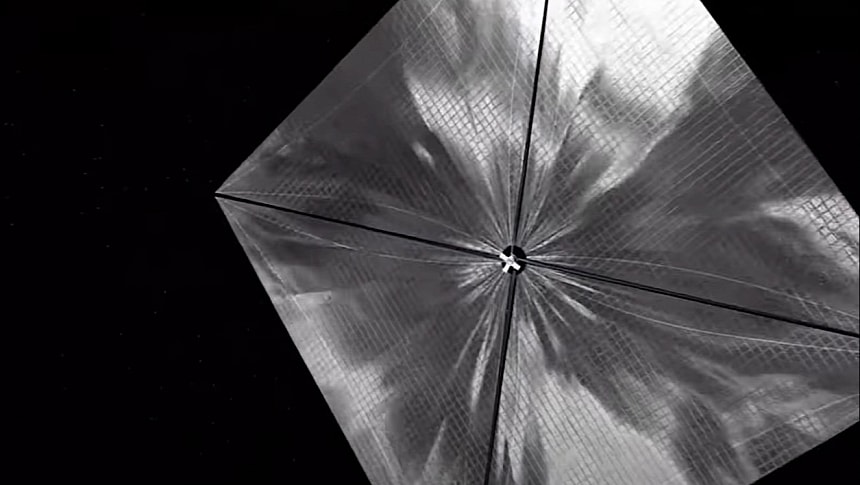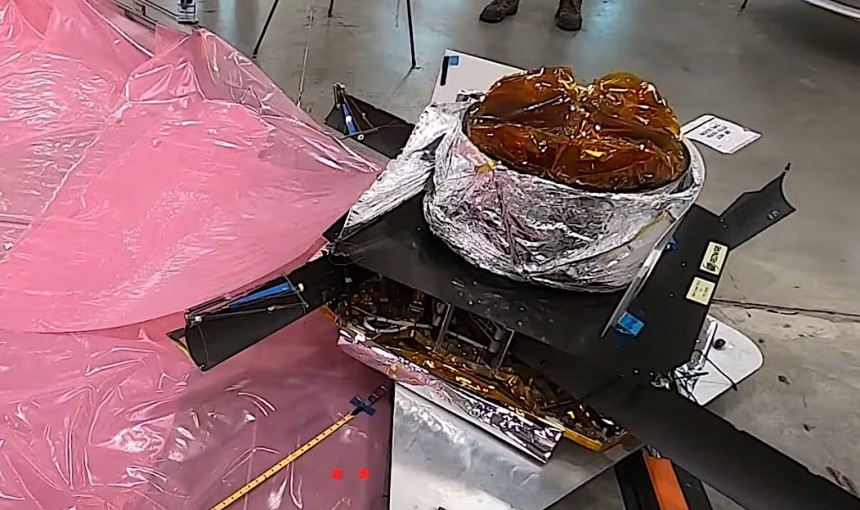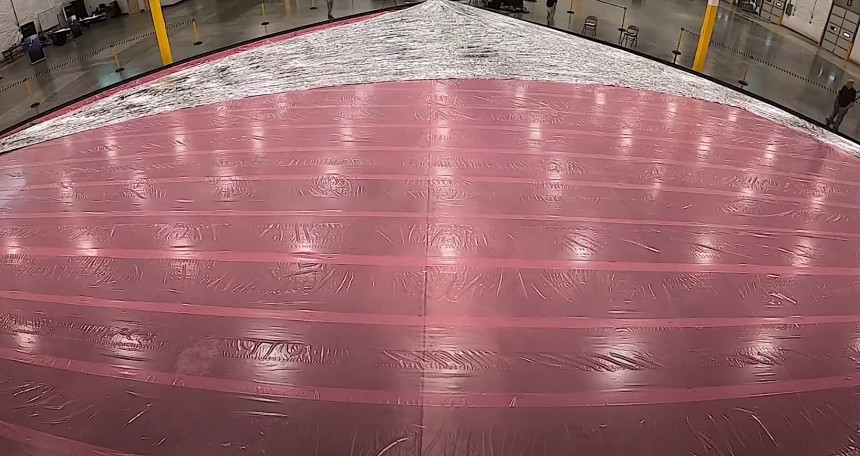In sci-fi literature and movies spacecraft powered by solar sails are pretty common. They are easy to make and fly, they require no on-board fuel to run and, given enough time, they have the potential to take you literally everywhere in this Universe of ours.
And pretty much the same thing applies in real life as well. The problem is, unlike in imagination land, we don't really have working solar sail spacecraft to play around with. At, least, not yet, as several companies, individuals, and even the American space agency are planning to change all that.
It's one of the NASA efforts that's of interest to us today, after the agency announced the completion of an important test on a solar sail tech that will be flown for real in space in the not-so-distant future.
The technology does not have a proper name for now, and it is the work of the Marshall Space Flight Center, which runs the project and is developing the "algorithms needed to control and navigate with the sail when it flies in space."
The agency is not alone in this, and it has the help of private companies Redwire and NeXolve. The former business supplies the deployment mechanism for the solar sail, while the latter is responsible for the membrane that captures sunlight, which will essentially form the engines of the spacecraft.
You all know or can easily imagine how a solar sail spacecraft works. Once in space, it deploys the sails, which are used to capture light and give the ship forward motion. It is the exact same principle sailboats use to navigate the seas of our world, using the power of the wind.
The NASA project relies on four identical solar sail quadrants to be attached to a ship and flown in space. The booms that support the sails are 100 feet long, and each of the light-reflecting surfaces is 17,780 square feet (1,652 square meters).
The sail itself is made of a polymer material coated with aluminum, thus its look of aluminum foil. It's just two and a half microns thick (that's less than the thickness of a human hair), but that should be enough to capture the light of the Sun and push the spacecraft forward.
That thing has quite a big surface, which means the spacecraft attached to these sails will have to be launched packed in some way. That, in turn, means the sail will have to be unfurled once in orbit. And it is this exact unfurling capability NASA announced it recently tested at the Redwire facility in Longmont, Colorado.
The test took place at the end of January, and marked the moment when NASA "cleared a key technology milestone" in the development of the spacecraft. Granted, only one of the four quadrants was deployed, measuring a total of 4,445 square feet/400 square meters. It was the first deployment test of the system, and even if it was only a partial one it proved the deployment tech and method work.
The space agency believes the solar sail it is working on is "ready for proposals to be flown on science missions." It's unclear at this point exactly what spacecraft will be used for the space test or when it will take off.
If it works, this tech and others like it might forever change the way we reach some of our goals in space. NASA is already considering solar sail as potential game changers for missions that will focus on space weather, but also exploratory missions of some other nature to new orbits around our planet and the Sun itself.
Because of their proximity to the Sun, Venus and Mercury could become prime targets for solar sail-powered missions.
Despite the many advantages over traditional means of propulsion in space, solar sails are however not the best choice when it comes to sending spacecraft deeper into the solar system, and even beyond. That's because the further away one gets from the Sun, the less powerful the propulsion from light becomes.
NASA, being NASA and all, is already thinking ahead and dreams of a time when light could even power interstellar ships. That's because a solar sail only needs light to work, and it doesn't really care where that light comes from.
As per the space agency there might come a time when lasers could be used for the task of accelerating a spacecraft to the speeds it needs to escape the boundaries of the solar system.
These lasers could be placed either on the surface of celestial bodies like Earth, or floating in space, to give the solar sails an extra nudge when they need it the most. As per NASA technologist Les Johnson, this method could accelerate a spacecraft "fast enough to reach another star in a reasonable amount of time."
We will keep an eye on this solar sail spacecraft story and update as soon as we learn more about the project and future plans for it.
It's one of the NASA efforts that's of interest to us today, after the agency announced the completion of an important test on a solar sail tech that will be flown for real in space in the not-so-distant future.
The technology does not have a proper name for now, and it is the work of the Marshall Space Flight Center, which runs the project and is developing the "algorithms needed to control and navigate with the sail when it flies in space."
The agency is not alone in this, and it has the help of private companies Redwire and NeXolve. The former business supplies the deployment mechanism for the solar sail, while the latter is responsible for the membrane that captures sunlight, which will essentially form the engines of the spacecraft.
You all know or can easily imagine how a solar sail spacecraft works. Once in space, it deploys the sails, which are used to capture light and give the ship forward motion. It is the exact same principle sailboats use to navigate the seas of our world, using the power of the wind.
The NASA project relies on four identical solar sail quadrants to be attached to a ship and flown in space. The booms that support the sails are 100 feet long, and each of the light-reflecting surfaces is 17,780 square feet (1,652 square meters).
That thing has quite a big surface, which means the spacecraft attached to these sails will have to be launched packed in some way. That, in turn, means the sail will have to be unfurled once in orbit. And it is this exact unfurling capability NASA announced it recently tested at the Redwire facility in Longmont, Colorado.
The test took place at the end of January, and marked the moment when NASA "cleared a key technology milestone" in the development of the spacecraft. Granted, only one of the four quadrants was deployed, measuring a total of 4,445 square feet/400 square meters. It was the first deployment test of the system, and even if it was only a partial one it proved the deployment tech and method work.
The space agency believes the solar sail it is working on is "ready for proposals to be flown on science missions." It's unclear at this point exactly what spacecraft will be used for the space test or when it will take off.
If it works, this tech and others like it might forever change the way we reach some of our goals in space. NASA is already considering solar sail as potential game changers for missions that will focus on space weather, but also exploratory missions of some other nature to new orbits around our planet and the Sun itself.
Because of their proximity to the Sun, Venus and Mercury could become prime targets for solar sail-powered missions.
NASA, being NASA and all, is already thinking ahead and dreams of a time when light could even power interstellar ships. That's because a solar sail only needs light to work, and it doesn't really care where that light comes from.
As per the space agency there might come a time when lasers could be used for the task of accelerating a spacecraft to the speeds it needs to escape the boundaries of the solar system.
These lasers could be placed either on the surface of celestial bodies like Earth, or floating in space, to give the solar sails an extra nudge when they need it the most. As per NASA technologist Les Johnson, this method could accelerate a spacecraft "fast enough to reach another star in a reasonable amount of time."
We will keep an eye on this solar sail spacecraft story and update as soon as we learn more about the project and future plans for it.









